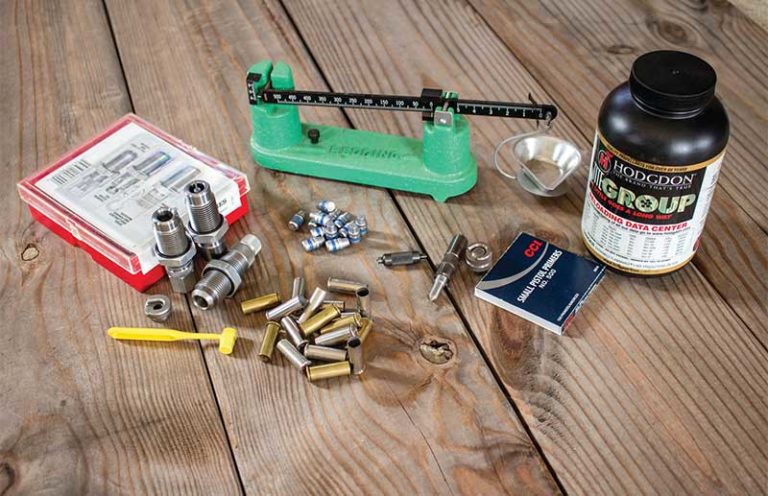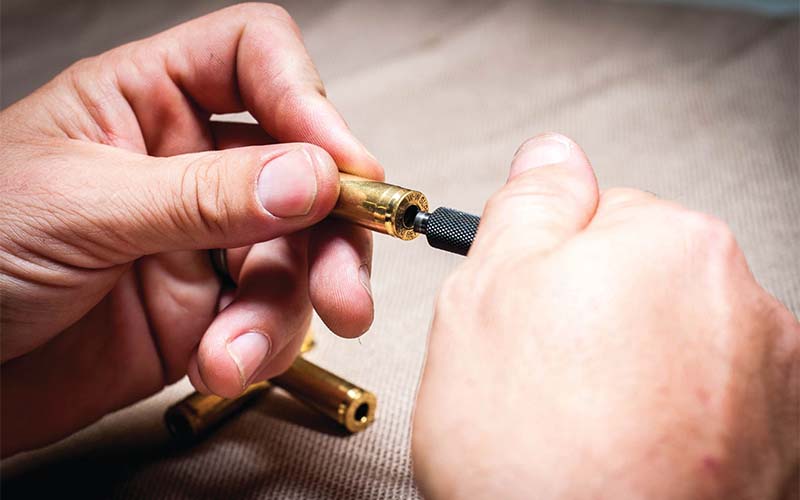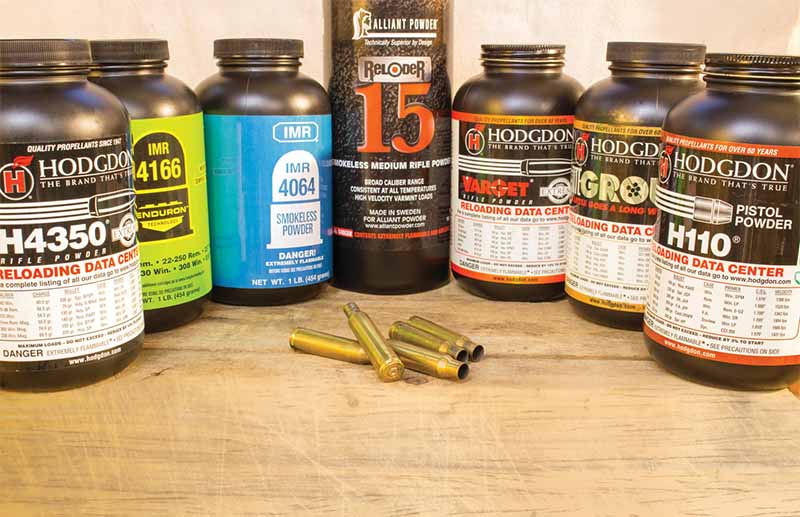
When ammo supplies are tight, keep on training by reloading pistol cartridges yourself.
This ammunition crunch is, quite possibly, the worst in living memory—surely worse than that of 2013. I receive numerous inquiries each week from folks who’ve become accustomed to sending a healthy amount of pistol bullets downrange, regarding how they can get into reloading pistol cartridges in an affordable yet effective manner. Let’s take a look at a minimalist setup for someone looking to make their own pistol ammo, keeping costs as low as possible.

One Piece At A Time
You’ll need projectiles, powder and primers, but you can reuse spent cases. While many of the bullet and powder companies publish their data online, I still love the reloading manuals. The manual will indicate the specific powder and its charge weight range, as well as the type and brand of primer used in the data published.
You’ll need a specific set of tools to get rolling, and while entry-level tools will suffice, I’ll wager you’ll upgrade once the reloading bug bites you. I’m outlining the simplest way to get going, simply to feed your handgun. And I’m concentrating on the most popular handgun cartridges, such as the 9mm Luger, .40 S&W, .45 ACP, .38 Special, .357 Magnum, etc.
The first tool is a reloading press, and while I most definitely prefer the additional strength of an “O” frame press for rifle cartridges, a “C” frame press will suffice for the straight-walled pistol cases. The Lee Breech Lock Reloader Single Stage press can be yours for under $40, and the Lyman Brass Smith C Frame—a bit more rugged and made of cast-iron—is just shy of $90. Both are sound choices, though I’d choose the beefier Lyman model.

Reloading dies serve several functions, including reducing a spent case back to the original dimensions (before expansion), knocking out a spent primer, flaring the case mouth for bullet seating, pressing a new bullet into the case and crimping that bullet in place. Lee offers dies that are a great value for the beginner, and I recommend them for this application.
In addition to the proper dies, Lee includes a shell holder (which works with any press) and a polymer scoop for measuring powder volumetrically. They even include load data based on their scoop volumes. So, while there might be fancier dies available, the Lee set will get the job done, at usually less than $50. And I definitely prefer the carbide dies—they won’t require any case lubricant.
You’ll need a reloading scale, and for the beginner, the balance-beam is the only way to go. There are many models at varying price points, but don’t go with the lowest bidder here. I like the RCBS M500 at around $75, and the Redding Model No. 2 for just under $100. This is an important piece of gear, as an incorrectly weighed powder charge could be catastrophic.
For trimming your cases, look to the Lee Case Length Gauge and Trimmer (about $8) of trimming cases to the appropriate length, though it might cost you some elbow grease. Trimming cases is especially important for the rimmed revolver cartridges because the roll-crimp needed to keep the bullets in place will be directly dependent on the case length.
You’ll need a pocket cleaner to scrape the residue out of the primer pockets, and for that I like the Lee Primer Pocket Cleaner. It’s two tools in one, with a scraper on either side to handle both large and small primer pockets. At a street price of about $6, you can’t go wrong. I’d also grab a Lee chamfer/deburring tool for $5 to take any sharp edges off the inside and outside of case mouths after trimming. It’ll result in ammunition that feeds better in semi-auto handguns.
A means of measuring cases, assembled cartridges and other associated items is necessary, look to a dial caliper or digital caliper. Frankford Arsenal makes a digital caliper that runs about $20, Hornady makes a dial caliper at around $40, and there are others. I have an RCBS digital caliper (about $80), which has been reliable for years, and there are much more expensive (and precise) models, but the inexpensive models will suffice if you handle them with care.

To seat new primers in your cases, you can use the priming arm and cup on your press—if it’s equipped with one—or you can use a hand primer. I like the RCBS Hand Priming Tool (about $40) or Lyman E-Zee Prime Universal Hand Priming Tool ($35 or so) to handle the priming of my cases, as they’re easy to use, give a great, consistent primer seating depth.
Dispensing powder can be done by hand with the Lee scoop, or even a simple spoon, directly into the pan of the balance beam scale, and I definitely recommend weighing each powder charge. If you so choose, you can spend the money on one of the mechanical powder throwers—the Lyman Brass Smith Powder Measure can be had for about $45—though for years I used a Lee scoop and an RCBS Powder Trickler (about $20) to fine-tune the charge.
To hold your cases while loading them, you can use a drill and a bit of appropriate diameter to drill holes in a block of wood, like a scrap of 2×4 or something similar, to create homemade loading blocks.
Feel The Powder
Powder choices for pistol cartridges are rather wide, as there are many ways to get the job done. Hodgdon’s Titegroup and Alliant’s Unique are but a couple of powders that’ll go a long way. There are 7,000 grains to the pound, and many pistol loads run on less than five grains of powder; this equates to around 1,400 shots to the pound of powder. Let’s say the average price of a pound of powder, before shipping and the HazMat fee, is $25, so you’ll pay less than $0.02 per shot. Primers will cost about 3 or 4 cents apiece, and bullet costs can vary widely.

The huge obstacle, at least at the time of this writing, is that the components and tools are selling like hotcakes as well, with many places out of stock. However, this dissertation sheds some light on what the minimum investment is to get up and running, and at the least, you can begin to collect the necessary tools for reloading ammunition—and hopefully, none of us will be caught in this predicament again.
Editor's Note: This article originally appeared in the 2021 CCW special issue of Gun Digest the Magazine.
Get More Reloading Info:
- Tips For Reloading the .30-06 Springfield
- Loving Your Luger: Reloading the 9mm Luger
- Handloading: Tips For Reloading The 7mm Rem Mag
- How To: Tips For Reloading the .223 Remington
- Reloading Bench: The Inside On Reloading For The .30-30 Winchester

Next Step: Get your FREE Printable Target Pack
Enhance your shooting precision with our 62 MOA Targets, perfect for rifles and handguns. Crafted in collaboration with Storm Tactical for accuracy and versatility.
Subscribe to the Gun Digest email newsletter and get your downloadable target pack sent straight to your inbox. Stay updated with the latest firearms info in the industry.

![Best Concealed Carry Guns In 2025 [Field Tested] Wilson Combat EDC X9S 1](https://gundigest.com/wp-content/uploads/Wilson-Combat-EDC-X9S-1-324x160.jpg)


![Best 9mm Carbine: Affordable PCCs [Tested] Ruger Carbine Shooting](https://gundigest.com/wp-content/uploads/Ruger-Carbine-Shooting-100x70.jpg)
![Best AR-15: Top Options Available Today [Field Tested] Harrington and Richardson PSA XM177E2 feature](https://gundigest.com/wp-content/uploads/Harrington-and-Richardson-PSA-XM177E2-feature-100x70.jpg)

Progressive press all the way. Life is too short.
Great advice for beginners to be sure. Here’s some of my experience;
I abandoned my balance beam scale for a much more precise electronic scale. Low end BB scales are notoriously wrong. Both are about the same price now.
Pistol cartridges mentioned in the article don’t need to be trimmed, they never stretch like rifle brass. More like they crack & split as the brass gets reloaded more times.
Molded pistol trays are so cheap that the effort to make your own is wasted.
Most pistol calibers enjoy fast burning powders like WW 231, RedDot, TiteGroup, WST, Bullseye & are more efficient with charges between 3.0-4.0 grains, however pistol powder is now U$40.00-$60.00 a pound.
Small pistol primers are over U$100.00 per thousand, making their cost almost the same as bullets.
I think the biggest way to stretch your reloading dollar is to cast your own bullets. A 6 cavity mold, a 20 pound casting pot, sizing kit & powder-coating setup will cost you about U$220.00. The mold pays for itself after the 1st 1000 cast & the other costs reduce quickly the more bullets you cast…..
Good article BUT, as stated by others, the cost of primers is over 4 times what they were. I’ve reloaded mostly straight walled pistol calibers since 1981. It’s been a rewarding, enjoyable and money saving hobby. Not any more. I can find projectiles and if I try hard even powder.
However there are no primers anywhere around these parts. Even if there were I could never afford to spend $150 on a 1000 primers that should cost less than $40. Over the years I’ve actually got a very long list of reloading equipment. I’m almost ready to sell it all.
Last timee I lookd , primrs were going fo 10+ cents or more .
Primers are the main issue for Reloaders right now, and they’re costing a lot more than 3 or 4 cents per primer. More like 10 to 15 cents per primer. So primers have more than doubled in price in a years time. Powder is typically $10 more per pound.
I’ve been reloading for 40+ years, and while I own an old RCBS Beam scale, I much prefer an Electronic Scale, and find it much easier to use and not subject to the vagaries of how my head is positioned to read the vernier beam on the old scale. It’s just as accurate and faster in my experience with it. I’ve a mix of equipment, Lee, RCBS, Lyman, Frankford, but I’m still using the same Lee O type press I bought 35+ years ago (I began the Reloading Journey with a Lee Load All, the mallet driven loader). Tens of thousands of rounds later, that cheap Lee press is still cranking cartridges out. Everything from .25 ACP up to .338 Win Mag, its handled without a hiccup.
When drilling a case block out of wood, use a Forstner bit or spade bit rather than a regular drill bit. The flat bottom hole works much better than the angled bottom a regular bit gives. Make several blocks with holes ranging in depth from 3/8″ to 1 1/2″. The deeper blocks are for long handgun cartridges and rifle cases, the shallower blocks for shorter pistol cases. For my blocks, I measure the length of the case, then divide that in half for the depth of the hole. This allows my powder funnel (which fits over, not into the case mouth) to ride on the case and not the block.
I love Reloading almost as much as I love shooting. The attention to detail, and precision satisfies my Inner Engineer. I’ve friends that have gone to Progressive Presses, that chide me for the time I spend using a single stage press, but I don’t mind the time I spend at the bench. Nothings more satisfying than having a cartridge you assembled yourself, perform flawlessly in the field or at the range.